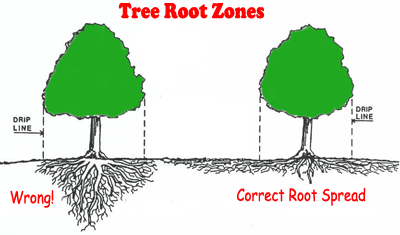We have all heard the old saying, “Let’s get to the root of the problem.” As a horticulturist, that simple phrase takes on a very deep meaning (no pun intended). Many of the plant problems I deal with every day have their origins at least partially in the root system. When it comes to older trees, root problems become a huge factor.
When a tree is under stress, most people notice the above the ground symptoms first and blame them on insects or diseases. It is easy to see wilting leaves, dying branches and loss of vigor. However when a large, established tree begins to slowly die over several years, the cause may lie hidden in the ground. The symptoms may arise from a much misunderstood area called the root zone.
 Roots serve several purposes in the life of a plant. They help to anchor the plant in the soil so it does not fall over. Roots also act as a storage locker for sugars and carbohydrates to help trees survive the winter. Their most important role is in the absorption of water and the nutrients dissolved in that water.
Roots serve several purposes in the life of a plant. They help to anchor the plant in the soil so it does not fall over. Roots also act as a storage locker for sugars and carbohydrates to help trees survive the winter. Their most important role is in the absorption of water and the nutrients dissolved in that water.
Some people believe that the root zone of a tree is a mirror image of its canopy. If the tree is 40 feet tall and 30 feet wide, then the root system must have the same dimensions. In reality, the vast majority of tree roots are located in the top 18 to 24 inches of soil. This is only logical since that is where the water and nutrients are located.
Sassafras, walnut, some oaks and a few other species form a true taproot which makes them difficult to transplant. They send thick anchoring roots deep into the ground but these constitute only a minor percentage of the total root system. Most trees do not form a true taproot.
Another commonly held myth is that the roots of a tree spread outward only to edge of the drip line. This is the outer edge of the canopy where water drips off the leaves. Although it varies by species, most trees have roots that grow way past the drip line. A few species actually send roots hundreds of feet away from the main trunk in all directions.
Understanding the extent and shape of a tree’s root system can be helpful in maintaining its health. The root system must be in “balance” with the canopy so that enough water and nutrients are delivered to support the leaves and stems. Damage to the root system will result in a loss of leaves, branches or, in severe cases, the entire tree. Conversely, loss of branches will result in a corresponding loss of roots.
Roots may be damaged in many ways. Soil excavation or rolling heavy equipment over the root zone is an obvious problem. Covering the roots with cement or piling a thick layer of additional soil over them is harmful too. Discharging water softener backwash, swimming pool chlorine or other chemicals on the soil over the roots may prove fatal. Excessive application or spillage of herbicides and fertilizers will also wreak havoc on roots below.
Damage may also occur in less dramatic ways. Thirty years of foot traffic and rain pounding on the soil may cause soil compaction. Compaction is perhaps the key nemesis of old landscape trees. When the soil becomes compacted, there is no room for oxygen. Roots must have oxygen in order to grow and do their jobs properly.
Planting a tree too close to houses, sidewalks, driveways or other obstructions will also limit the expansion of the root zone. As the tree grows, it needs more roots and such restrictions can cause serious problems in later years.
The key is to be aware of the potential damage that any activity may have on the root zone of a tree. Tiny root hairs are most responsible for water and nutrient absorption. They are also the first to be destroyed when the root zone is bothered.
